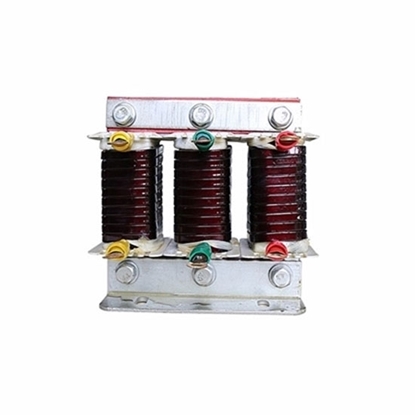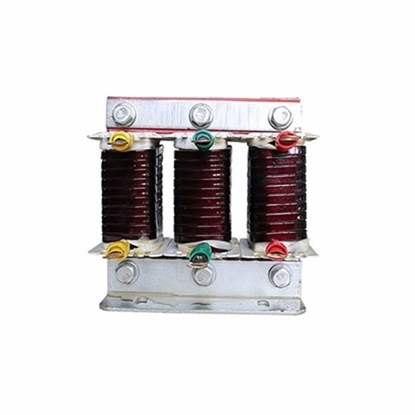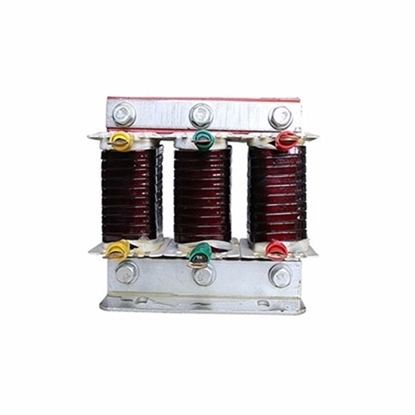AC Reactors
75 hp (55 kW) AC Line Reactor, 3 Phase Output
100 hp (75 kW) AC Line Reactor, 3 Phase Output
150 hp (110 kW) AC Line Reactor, 3 Phase Output
AC line reactor is an instrument used on the load side of the VFD, three phase input or output. The line reactor coil has good insulation performance, high overall mechanical strength and good moisture resistance. The coils are F and H insulation grades, which greatly improves the reliability of long-term operation. ATO sells line reactors at the best price, with power ranges from 2 hp to 150 hp input/output.
AC reactor features
- AC linereactor is divided into two types: single-phase iron core dry structure and three-phase dry structure.
- The core of AC reactor adopts high quality low-loss cold-rolled silicon steel sheet, and the core column is divided into small uniform sections by several air gaps, and the air gaps are spaced by epoxy laminated glass cloth plates and coated with special adhesive to ensure that the air gaps of reactor do not change during operation and there is no noise.
- The coils are made of F or H grade enameled copper flat wire, closely and evenly arranged, without insulation layer on the outside, with layer structure for small capacity coils and pancake structure for large capacity coils, with good ventilation and heat dissipation.
- After the coil and core of AC reactor are assembled into one, they go through the process of pre-baking - vacuum impregnation - hot baking and curing, and H-level impregnation paint is used to make the coil and core of the reactor firmly combined, which not only greatly reduces the noise during operation, but also has a very high heat-resistant grade. And it has a very high heat resistance grade, which can ensure the reactor can operate safely without noise even at high temperature.
- The fasteners of AC reactor cores are made of non-magnetic materials, which ensure the reactor has a low temperature rise.
- The exposed parts are treated with anti-corrosion treatment, and the lead terminals are made of Satons tinned copper tube terminals or copper rows.
- The AC line reactor used in the role power network is essentially a hollow coil with no permeable material. It can be arranged in three assembly forms: vertical, horizontal and zigzag, as required. In the event of a short circuit in the power system, a large value of short circuit current is generated. It is very difficult to maintain the dynamic and thermal stability of electrical equipment if it is not limited. Therefore, in order to meet the requirements of some circuit breaker blocking capacity, often in series at the outgoing circuit breaker reactor, increase the short-circuit impedance, limit the short-circuit current.
The role of AC line reactor
AC input line reactor can restrain the harmonic current, improve the power factor and weaken the impact of surge voltage and current in the input circuit, weaken the influence of the power supply voltage imbalance, use it to limit the voltage mutation of the power grid and the current impact caused by overvoltage, smooth the peak pulse contained in the voltage of the power supply, and effectively protect the frequency conversion. AC line reactor can not only prevent interference from power grid, but also reduce the pollution caused by harmonic current generated by rectifier unit.
The role of AC input reactor
- Reduce harmonic interference of inverter to the grid.
- Improve the quality of the power grid, improve the power factor of the inverter system, reduce reactive power.
- Reduce the impact of power surges on the inverter and improve the reliability of the inverter system.
The role of AC output reactor
- Improve the insulation characteristics of the motor, extend the service life of the motor.
- Improve the output current waveform.
- Extend the safety distance from the motor to the inverter.
For the industrial control automation industry, the AC reactor at the input end of the inverter can absorb the surge of the power grid and the operating overvoltage to protect the equipment behind the inverter, and at the same time suppress the power frequency harmonic current of the inverter and improve the power factor.
How to select the input reactor?
Rated current
The rated AC current is the long-term operating current of the reactor designed from the aspect of heat generation, while sufficient high harmonic components should be considered. The current value must be greater than or equal to the rated value of the motor.
Voltage drop
The voltage drop is the actual voltage drop across the reactor coil at 50HZ corresponding to the actual rated current. The rated voltage drop of the incoming reactor, UN is the line voltage voltage, UP is the phase voltage, and the voltage drop is usually chosen to be around 4V~8V.
What are the uses of the AC line reactor in power system?
Restrict the short-circuit current
When the power system has short circuit, it will generate a very high short-circuit current. In order to guarantee the dynamic stability and thermal stability of the electrical equipment, the reactor is usually connected to the outgoing breaker in series, so as to increase the short-circuit impedance and restrict the short-circuit current. Because of the application of the reactor, the voltage drop on the reactor is high in case of a short circuit. It also plays the role of maintaining the voltage of the busbar, ensuring the small voltage fluctuation of the busbar and guaranteeing the operation stability of the electrical equipment on the non-fault line.
Restrict the higher harmonic
Because a large amount of power electronic devices have been used in the power system, especially high-power DC and frequency conversion equipment, which generate plentiful harmonics, the compensating capacitor is frequently damaged, and in serious conditions, the compensating capacitor is unable to be put into operation. When the harmonic is rather low, the harmonic suppressor can be used. When the harmonic in the power system is rather higher, the reactor in series can be adopted. The higher harmonic in the power grid can be restricted through connecting the capacitor in serious or parallel in the water filter.
Reactive compensation
Reactive balance is very important in enhancing the economic benefit of the power system and improving the power supply quality. Meanwhile, it is required to conduct dynamic regulation, and provide more capacitive reactiveness in load peak, so as to satisfy the reactive demand of the industrial and mining enterprises, stabilize the system voltage. On the other hand, it should be able to provide sensible reactiveness, so as to balance the charging power of the cables in fractional loading, ensuring the not too high voltage of the system. LC series circuit constituted by the capacitor and reactor in series has the function of restraining a certain frequency harmonic. Usually, the low-voltage series reactor is used to restrain the harmonics for three, four and five times.
Arc extinguish reactor
Arc extinguish reactor is connected between the neutral point and ground of the three-phase transformer. When one phase of the three-phase power grid is connected with the ground, the induction current can be supplied, so as to compensate the capacitive current flowing through the earthing point, enabling the nonflamability of the arc, so as to avoid having overvoltage caused by the repeated ignition of the arc. The arc extinguish reactor is widely used for the resonance earthing system of 6kV~10kV.
Phase shifting function
Phase shifting means that the waveform of the AC signal fails to change as the original angle and presents an angle change. The function of phase shifting reactor is to reduce the influence of the harmonic current and voltage generated by the semiconductor converter device and non-linear load to the power supply system. It is a new method for the converter power supply system to restrain the harmonic wave. Because in the three-phase symmetrical power supply system, generally the 5th, 7th, 11th, and 13th harmonics have greater contents and more serious influence to the system, the phase shifting electric reactor is designed to weaken these harmonics.
Input line reactor is mainly used in the industrial automation control to restrain the surge voltage and current generated by the frequency converter and speed regulator, so as to decay the high-frequency and distorted harmonics in the system to the greatest extent, limit the current impact caused by power grid voltage mutation and overvoltage operation.
Output line reactor is also called as the motor reactor. It is mainly used in the industrial automation system, especially occasions with frequency converter, to extend the valid transmission distance of the frequency converter, effectively restrain the transient high voltage in switching on/off the IGBT module of the frequency converter. It is suitable for compensating the distributed capacitance, restraining the output harmonic current, effectively protecting the frequency converter and improving the power factor, with an expectation to reduce the pollution of the harmonic current generated by the rectification unit to the power grid.
When do VFD need to be equipped with input reactor?

- The ratio of power supply capacity to inverter capacity used for VFD is 10:1 or more, as shown in the figure.
- The same power supply is connected to a thyristor device or a power factor compensation device with switching control.
- Because the thyristor device is also easy to make the voltage waveform of the grid distortion, and the inverter affect each other. Therefore, the input side of the inverter and the input side of the thyristor device should be connected to the AC reactor.
- The voltage imbalance of the three-phase power supply is large (≥ 3%)
- Inverter three-phase rectifier bridge in the operation process, because the voltage on the filter capacitor is not constant when the voltage of each phase is close to the amplitude value, therefore, the size of the three-phase charging current is often unbalanced. The unbalance of the line voltage will lead to more unbalance of the three-phase input current of the inverter. Therefore, when the unbalance of the three-phase voltage is >3%, the access to the AC reactor should be considered.
- Voltage integrated deformation rate > 5%, AC reactor or DC reactor should be added to suppress harmonic current.
Due to the larger size and higher cost of AC reactor, the configuration of AC reactor is considered only when the power of frequency inverter > 30kW.




